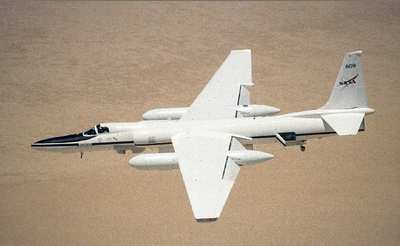Will Use Research Aircraft, Satellites To Sample Storm Cloud
Particles
 NASA's Tropical Composition, Cloud
and Climate Coupling (TC4) field campaign will begin this summer in
San Jose, Costa Rica, with an investigation into how chemical
compounds in the air are transported vertically into the
stratosphere and how that transport affects cloud formation and
climate.
NASA's Tropical Composition, Cloud
and Climate Coupling (TC4) field campaign will begin this summer in
San Jose, Costa Rica, with an investigation into how chemical
compounds in the air are transported vertically into the
stratosphere and how that transport affects cloud formation and
climate.
The study will begin the week of July 16 with coordinated
observations from satellites, high-flying NASA research aircraft,
balloons and ground-based radar. The targets of these measurements
are the gases, aerosols and ice crystals that flow from the top of
the strong storm systems that form over the warm tropical ocean.
These storm systems pump air more than 40,000 feet above
Earth’s surface, where it can influence the composition of
the stratosphere, home of our planet’s protective ozone
layer.
The outflow of these storms also produces vast swaths of icy
cirrus clouds that play an important role in how much infrared
energy is trapped in Earth's atmosphere. Scientists want to
document the full life cycle of these widespread clouds -- down to
the size and shape of their tiny ice crystals -- to better
understand how Earth will react to a warming climate.

"This campaign is an unprecedented opportunity to use NASA's
complete suite of satellite and airborne Earth-observing
capabilities to investigate a largely unexplored region of the
atmosphere," said Michael J. Kurylo, a TC4 program scientist at
NASA Headquarters in Washington. "This tropical transitional layer
of the atmosphere between the troposphere and the stratosphere
plays a key role in both climate change science and atmospheric
ozone chemistry. The data will yield new insights into the
composition of this layer and the impact of the deep clouds that
penetrate the atmosphere up into this layer."
The effort runs through August 8. It is NASA's largest Earth
science field campaign of the year.

"A mission this complex, with three aircraft, deployment sites
in Costa Rica and Panama, and more than 400 people involved, can be
a real challenge," said Mission Project Manager Marilyn Vasques of
NASA Ames Research Center, Moffett Field, CA.
Soaring high above the cloud systems will be a NASA ER-2
aircraft, which can reach an altitude of 70,000 feet, or three
miles into the stratosphere. A NASA WB-57 aircraft will fly into
the cirrus clouds and sample the chemical make-up of the storm
systems’ outflow. NASA's DC-8 aircraft will probe the region
between the troposphere and the stratosphere (known as the
tropopause transitional layer) with remote-sensing instruments. It
also will sample cloud particles and air chemistry at lower
altitudes. A weather radar and meteorological balloons will be
deployed in Panama to support the campaign. Additional balloons
will be launched from Costa Rica and San Cristobal Island in the
Galapagos Archipelago.
 Observations from seven
satellites will complement the aircraft measurements with
large-scale views of many different features of the atmosphere. For
example, the Aura spacecraft will focus on the chemical composition
of the tropopause transitional layer and measure ozone, water
vapor, carbon monoxide and particles. NASA's Aqua satellite will
map thin cirrus clouds, some of which are so faint they are nearly
invisible to the naked eye. Instruments on the CALIPSO and CloudSat
satellites will pierce the atmosphere to provide vertical profiles
of clouds and aerosol particles that can change how clouds
form.
Observations from seven
satellites will complement the aircraft measurements with
large-scale views of many different features of the atmosphere. For
example, the Aura spacecraft will focus on the chemical composition
of the tropopause transitional layer and measure ozone, water
vapor, carbon monoxide and particles. NASA's Aqua satellite will
map thin cirrus clouds, some of which are so faint they are nearly
invisible to the naked eye. Instruments on the CALIPSO and CloudSat
satellites will pierce the atmosphere to provide vertical profiles
of clouds and aerosol particles that can change how clouds
form.
Along the coasts of Colombia and Panama south
of Costa Rica, the warm summer waters of the Pacific Ocean are a
fertile breeding ground for the type of heat-driven, or convective,
storm systems the mission is targeting. Clouds produced by these
maritime systems produce heavy rainfall and cloud tops that can
reach into the transitional layer.
Mission scientists want to know what effect a warming climate
with rising ocean temperatures will have on the intensity of these
storm systems. Another unknown is how aerosol particles swept up in
these systems change the clouds and are, in turn, affected by the
clouds.
These tropical convective systems also may play a role in the
recovery of the ozone layer. Estimates of ozone destruction in the
stratosphere typically minimize the impact of short-lived chemical
compounds that presumably could not survive the long journey there.
Mission scientists will investigate whether the rapid movement of
air in these strong convective systems provides an express route
for ozone-destroying compounds to reach the stratosphere.
The Earth Science Division at NASA Headquarters is sponsoring
the $12 million mission. Costa Rica's National Center for High
Technology, San Jose, and the University of Panama, Las Tablas, are
cooperating with NASA on the mission as are other US agencies, such
as the National Oceanic and Atmospheric Administration and the
National Science Foundation.
 ANN's Daily Aero-Term (05.01.24): Say Altitude
ANN's Daily Aero-Term (05.01.24): Say Altitude ANN's Daily Aero-Linx (05.01.24)
ANN's Daily Aero-Linx (05.01.24) Classic Aero-TV: Korean War Hero Twice Reborn
Classic Aero-TV: Korean War Hero Twice Reborn Airborne 04.29.24: EAA B-25 Rides, Textron 2024, G700 Deliveries
Airborne 04.29.24: EAA B-25 Rides, Textron 2024, G700 Deliveries Airborne Affordable Flyers 05.02.24: Bobby Bailey, SPRG Report Cards, Skydive!
Airborne Affordable Flyers 05.02.24: Bobby Bailey, SPRG Report Cards, Skydive!






